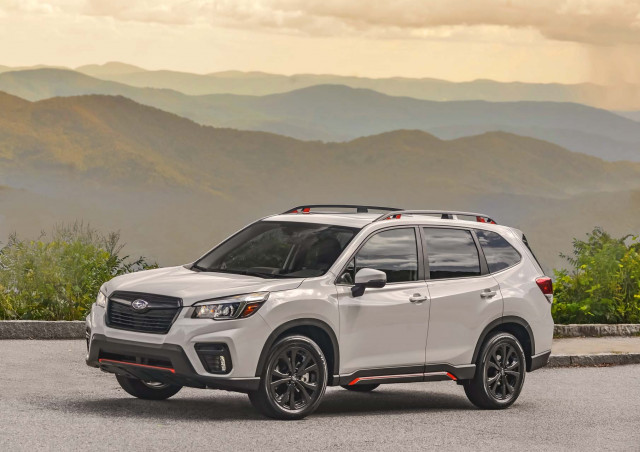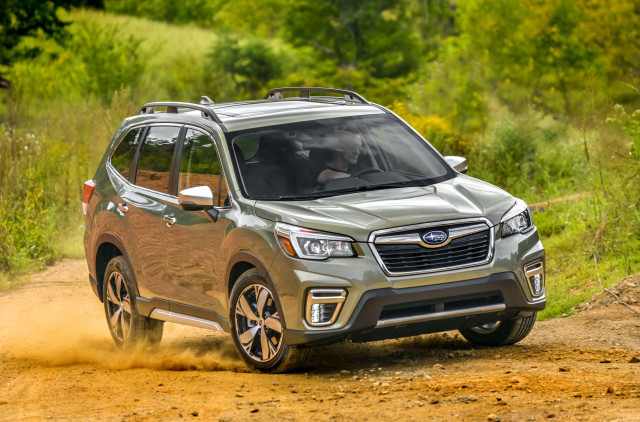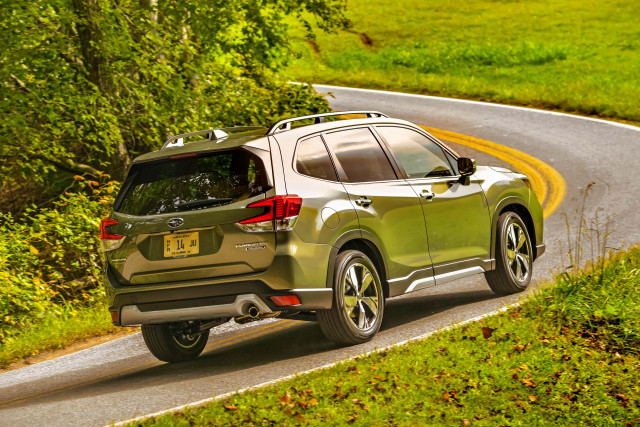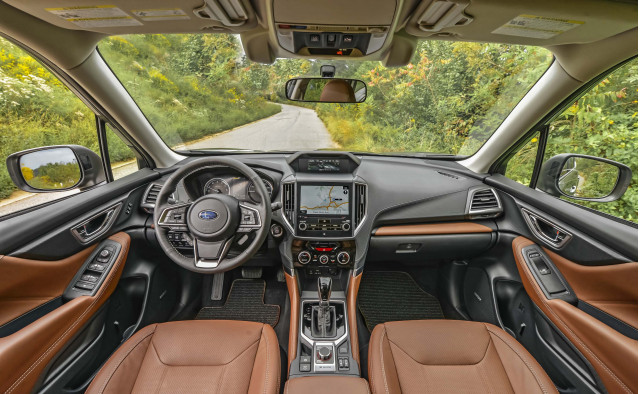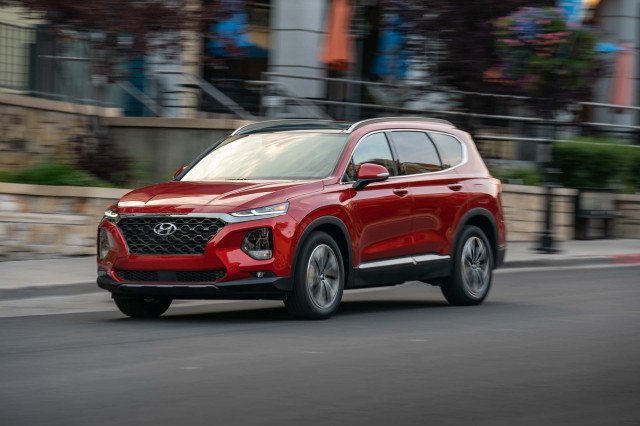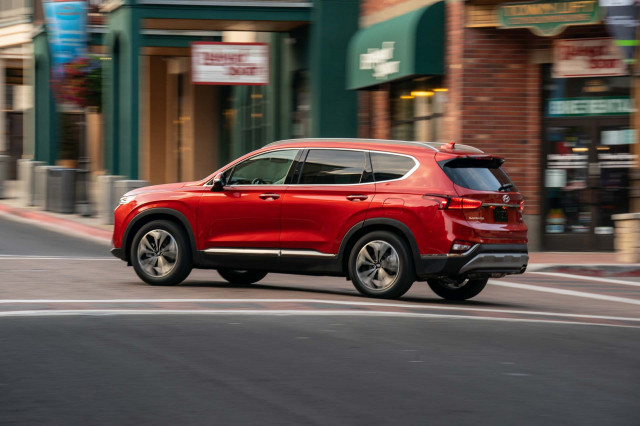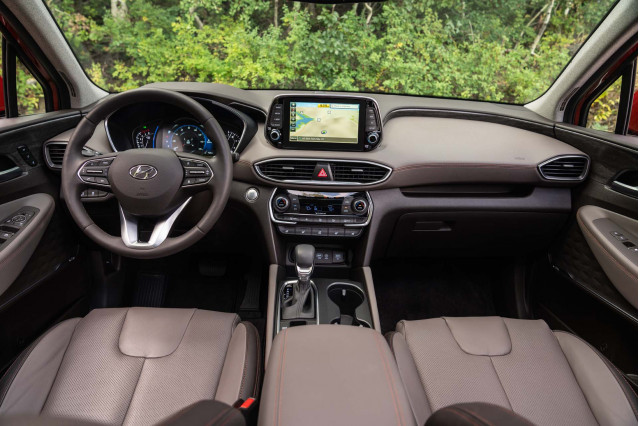2019 Subaru Forester Sport
Compact crossover SUV shoppers are spoiled for choice. Two models that rise to the top of our ratings are the 2019 Subaru Forester and 2019 Hyundai Santa Fe.
Each has its own take on what’s best for everyday driving. Overall, we think the 2019 Forester’s combination of value, interior space, and fuel economy edges it ahead in our ratings. However, the 2019 Santa Fe has a luxurious interior and a stronger turbo-4 engine, which tips the balance in its favor for some needs.
Overall, we rate both the 2019 Forester and 2019 Santa Fe at 6.4 out of 10 points. Like we said, it’s a close call. (Read more about how we rate cars.)
The 2019 Forester comes in five trim levels, all of which have all-wheel drive and a 2.5-liter flat-4 engine rated at 182 horsepower paired to a continuously variable transmission. The flat-4 provides good acceleration at city speeds but can feel out of breath during highway passing or when climbing long grades.
2019 Subaru Forester
2019 Subaru Forester
2019 Subaru Forester
We feel the same way about the 2019 Santa Fe’s standard 2.4-liter inline-4, which is rated at 185 hp. The optional 235-hp turbo-4 in the Santa Fe delivers better acceleration, but it’s costly and thirsty.
No matter how you spec one out, the Forester is rated at 26 mpg city, 33 highway, 29 combined. The Santa Fe disappoints at just 21/27/23 mpg with all-wheel drive. Turbocharged Santa Fes are thirstier yet at just 19/24/21 mpg with all-wheel drive. True, the Santa Fe is available with front-wheel drive, but even the most miserly is rated at a mere 25 mpg combined.
Both crossovers have a soft, compliant ride. The Forester better isolates rough roads than the Santa Fe, but the difference is only apparent when they’re driven back to back.
We prefer the Santa Fe’s curvaceous styling to the upright, boxy Forester. That said, the Subaru’s tall windows, low window sills, and narrow roof pillars mean it delivers far better outward vision.
The Forester’s interior is thoughtfully arranged, with comfortable front seats covered in either tough cloth or solid leather upholstery. Its rear doors open especially wide for terrific access—an asset for parents with children in car seats, for instance. And the Forester’s cargo area holds as much as 76 cubic feet of luggage with the rear seats folded.
2019 Hyundai Santa Fe
2019 Hyundai Santa Fe
2019 Hyundai Santa Fe
Passengers will find a more imaginative design with unique materials and surface graining in the Santa Fe, but it’s not as spacious. Maximum cargo capacity stands at just 70 cubic feet and the Hyundai’s door and tailgate openings are not as wide as those on the Subaru.
The Santa Fe starts at about $26,500, which and for that price it includes active safety tech such as automatic emergency braking, active lane control, blind-spot monitors, and rear cross-traffic alerts. The Forester costs $25,400 to start. It trades the Hyundai’s blind-spot monitors and rear cross-traffic alerts for all-wheel drive.
Both crossover SUVs come from automakers with good reputations for crash safety, but they haven’t been fully tested by independent and federal regulators yet.
The Forester we’d be happiest with is the Premium trim level with a few options that bring its price to about $29,500. It includes alloy wheels, tinted windows, heated front seats, a power liftgate, a panoramic moonroof and a decent 6.5-inch infotainment touchscreen with Apple CarPlay and Android Auto compatibility.
An equivalent Santa Fe SEL with all-wheel drive costs about $30,300, but it does without a sunroof. It’s rare that we recommend the best-equipped version of a crossover SUV, but the Santa Fe Ultimate with the turbo-4 engine and all-wheel drive bests many luxury cars for its features, its refinement, and its performance for about $39,500.
If it’s a reasonably priced all-weather family-hauler you’re after, the 2019 Subaru Forester is tough to beat. For those seeking more luxuries without spending for an Audi or BMW, the 2019 Hyundai Santa Fe makes a compelling case for itself without breaking the bank.
Summary
Styling
Performance
Comfort & Quality
Safety
Features
Fuel Economy
MSRP
Invoice
Fuel Economy – Combined City and Highway
Engine
Drivetrain
Source: Read Full Article

